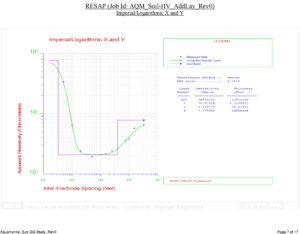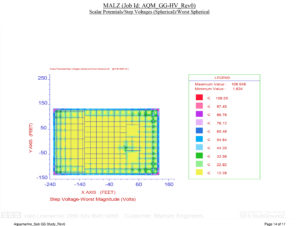Blymyer Engineers designs a significant number of substations each year. These substations include a substation ground grid, which is crucial to the safety of the facilities. Engineering a ground grid requires taking a number of variables, such as soil type, into consideration. The Blymyer team uses CDEGS (Current Distribution, Electromagnetic fields, Grounding, and Soil structure analysis) software to model grounding systems.
“Grounding is important for safety,” explains Blymyer President Mike Rantz. “Grounding reduces the risk that people will come into contact with dangerous voltages. You need experience and expertise to ensure that ground grid designs are effective.”
Why grounding is so important
The grounding system in any substation is an important part of the design. Grounding protects people and equipment by providing a means to carry electric currents into the earth under normal and fault conditions. During a ground fault, the current or a portion of the ground current flows through the earth, creating the voltage gradient. A person standing near the fault can receive a dangerous electric shock due to step voltage (the potential difference between the feet) and touch voltage (the potential difference between a metallic object and the earth).
Alexey Kondrashov, a senior electrical engineer with Blymyer, explains: “The effect of that portion of fault current that enters the earth within the substation area must be analyzed. We study it to ensure that the potentials are within safe limits. This ensures a safe working area for technicians within the substation yard.”
A closer look at the engineering
A complex network of conductors connects the conductive components of a substation to the earth. The network is called a ground grid. There are several variables that affect the results studies that inform the engineering of a ground grid. These include—but are not limited to—fault current magnitude, the geometrical parameters of the grid itself, the depths of buried conductors, and soil parameters. Below you see a model of a ground grid.
The modeling is performed using CDEGS software from SES Technologies. The software builds a model based on the variables noted above. One of the important inputs is the soil model. An accurate soil model requires soil electrical resistivity measurements of the actual soil at the substation location. Below you see a soil model.
After the designer enters all the inputs, the software generates a report and plots. These are further analyzed. If necessary, the designer makes any needed corrections to the grid design. After grid construction, the Blymyer team performs field tests to ensure consistency with the modeled results. Below you see a results plot.
About CDEGS software
Safe Engineering Services and Technologies (SES) offers the CDEGS suite of software that Blymyer uses. The company was founded in 1978. SES is a leading authority on grounding, lightning, and electromagnetic interference. The Blymyer team takes advantage of the extensive training offered by SES.
“CDEGS software lets us understand real-world conditions through accurate modeling,” says Kondrashov. “As certified users, we learn how to model potential issues and avoid problems.”



